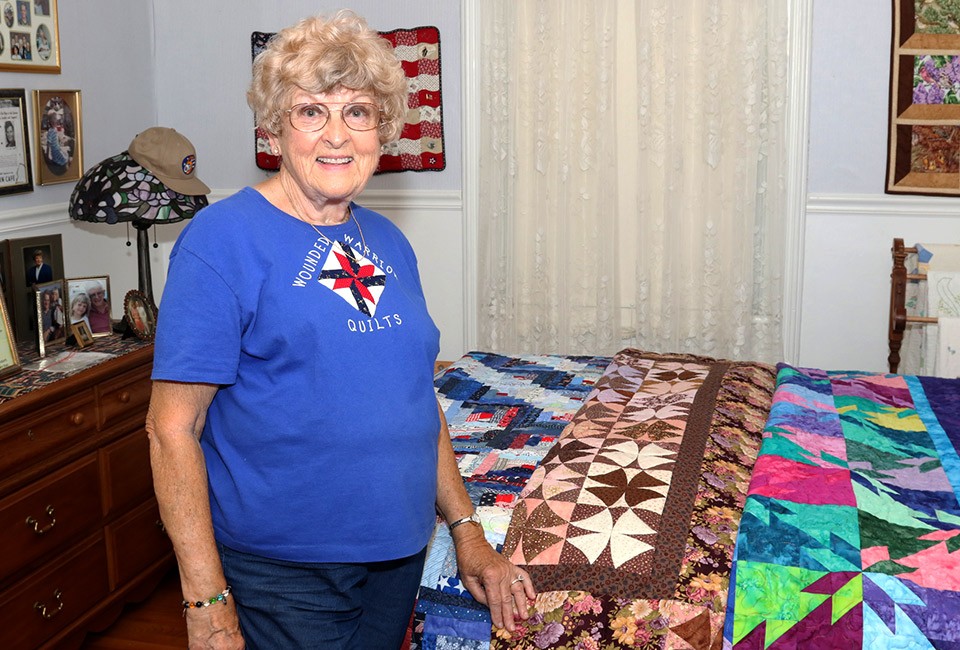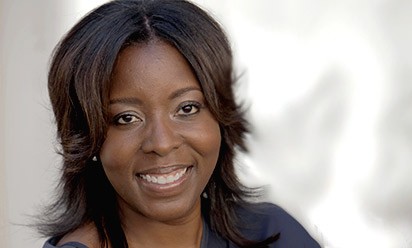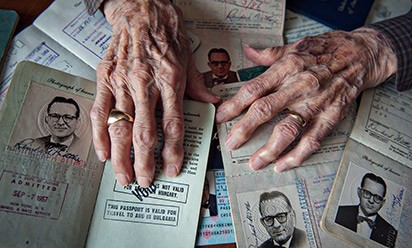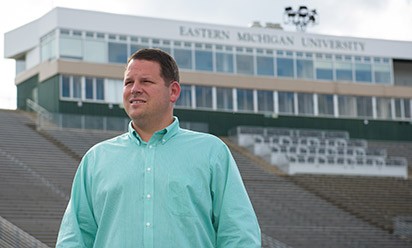Made With Love
Wounded Warrior Quilt Project has produced hundreds of quilts for wounded soldiers

Physically, the twin-sized quilt with an alternating light and dark pattern is just 120 pieces of fabric, each of them 6.5 square inches. There are also, to be sure, stitches, backing, batting between the layers … and the four squares that bear special messages. As craft projects go, though, it’s pretty simple.
But to a young soldier waking at Germany’s Landstuhl Regional Medical Center to the reality of life with one leg instead of two, it became so much more. He began to sob when he reached down after his amputation to where his other leg had been. That’s when an attendant slipped the quilt around his shoulders. It brought him so much comfort that he asked to take it with him when he transferred stateside.
Since the death of her husband, a World War II fighter pilot named Joseph L. Ross, in 2005, Patrecia Ross (BS66, MA70) had worked tirelessly with some fellow members of her local chapter of the Blue Star Mothers of America (BSMA) to make quilts for wounded American soldiers and ship them to Landstuhl. Now that group was disbanding, and Ross wondered if it was time to hang up her thimble.
But after she read the young soldier’s story in a letter from a nurse who had been there, quitting was out of the question. “‘Can I take my quilt?’ Those five words kept me working,” says Ross.
Ross had sewn since her mother taught her how, but it wasn’t until after she retired that she came up with the idea of quilting for wounded soldiers. The first year, she worked with her mother over the winter and they produced 20 quilts between them. After her mother and her husband passed away, she became a snowbird, keeping a summer home in Marlette and travelling to Estero, Fla., for the winter months, where she connected with the BSMA to continue her growing passion.
It was seven years ago that Ross received that fateful letter, just as the BSMA group was breaking up. So she founded her own, the Wounded Warrior Quilt Project (WWQP), which is still going strong and has grown to a contingent of 50 retired women who live in Corkscrew Woodlands, the neighborhood Ross calls home from fall to spring.
“I found a lot of ladies who weren’t quilters but they had had careers, taught or did this or that,” says Ross, who taught language arts in Trenton for 40 years. “They had time on their hands in retirement and this project gave them a new purpose.”
To accommodate their skill level, Ross employed a method made famous back home in Michigan. She designed a quilting assembly line—complete with five sewing machines, four ironing boards and five irons—and taught each woman how to do an individual task, from cutting to tying, ironing and sewing. They didn’t need to learn to quilt, just to do one job.
For one woman, that job is to produce the four special patches that go on each quilt. Their messages are “Love to you, wounded warrior, from Estero, Florida,” “God bless America,” “Peace from God be unto you,” and Ross’ favorite, “In memory of Joseph L. Ross, WWII B-17 bombardier.”
So far, WWQP has produced 799 quilts, sending them to the VA hospital in Tampa, Fla., as well as Landstuhl.
Her perseverance reflects a lifetime of meeting and overcoming challenges. Ross’ husband survived being shot down twice over the Pacific Ocean, then came home to a job as a teacher in a small town (Marlette). That’s where he met Patrecia, a high school student who was 12 years his junior.
“People said it wouldn’t last because of the age difference.” Ross chuckles. “We were married 52 and a half years. He was 90 when he passed and I took good care of him.”
She and her husband raised three children and, with his encouragement, she received her bachelor’s in education in 1966 at Eastern, then returned to earn her master’s in 1970. An accomplished pianist in addition to her other talents, Ross gave piano lessons to help pay for her coursework en route to a PhD from the University of Michigan in 1981.
“EMU made me who I am today. I’ve lived a good life,” says Ross.
Now her life is still dedicated to making the lives of others better, even if it’s just in providing the comfort of a quilt to those who are hurt and far from home.
Contact Darcy Gifford, dgiffor2@emich.edu , 734.487.5375

 EMU alumna Ayanna Floyd Davis proclaimed herself a Hollywood writer. Then she became one.
EMU alumna Ayanna Floyd Davis proclaimed herself a Hollywood writer. Then she became one.
 Reinhard Wittke helped the EMU community see the world, leading 47 international tours during his time at Eastern.
Reinhard Wittke helped the EMU community see the world, leading 47 international tours during his time at Eastern.
 Q&A with Vice President and Director of Athletics
Q&A with Vice President and Director of Athletics